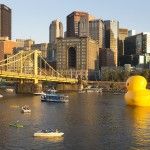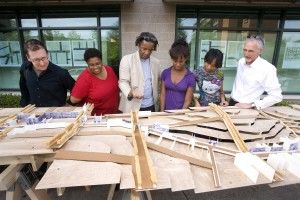Pittsburgh is a post industrial success story. I have lived here long enough to bear witness. Recent recovery from the great recession of 2008 has been strong in comparison to fifteen other benchmarked cities, including the likes of Boston and Denver. Once almost wholly dependent on big steel, the Pittsburgh regional economy is now much more diverse, relying on education, medicine, high-technology and service industries. Young people – twenty to thirty five years old – are staying on after college or moving to Pittsburgh even from hip places like Washington D.C. and New York, most of them commanding substantial salaries. My younger son is a case in point. His travel-heavy IT job with a multinational is not place specific. On the road a lot, he recently relocated his home base from Brooklyn to Pittsburgh. Social ties were a factor- he grew up in the area and has friends here -but it really helped that Pittsburgh is a happening place. I remember Lawrenceville, his chosen neighbourhood, as an ageing White working-class area adjacent to the Allegheny River, a tight knit place with plenty of vacant or abandoned buildings. In the last decade in particular Lawrenceville has morphed into a place of galleries, antiques shops, cafes and restaurants, blended with older local fixtures like Hambone’s bar and the bowling alley. Nor is it the only place attracting the young and hip.
On a recent First Friday evening, I walked along Penn Avenue in Garfield for Unblurred, a monthly evening of art, music and food. Penn Avenue connects mostly poor and Black Garfield with mostly middle class, white and substantially renovated Friendship. My friend Jack Hutchings had been a pioneer in the 1990’s opening one of the first galleries, Garfield Artworks, along that section of Penn.
To draw more than a miniscule crowd, our band Inish played at fringe art openings in the space. Now, thanks to decades of perseverance by community organizations like the Bloomfield Garfield Corporation (BGC) and Penn Avenue Arts Initiative, the strip is populated with funky galleries and artisans shops. For Unblurred, the entire street was jumping; people and music poured from the galleries. Shoulder to shoulder with the mob, my wife and I, decidedly in the minority of Boomers on hand, made our way through an old church building packed with twenty-something self-publishing graphic artists and ran into Rick Swartz, BGC director for over twenty five years.
“Do you remember the days, Denys,” he asked, “when we could have rolled a bowling ball down the middle of Penn avenue without fearing it would hit anything?” I do indeed.
But all is not rosy, not in Pittsburgh and even less so in other post industrial cities. While social and economic inequality is pervasive throughout the post-industrial world, it is especially stark in the USA where the middle class is disappearing and upward mobility is choked off like never before, though relatively worse in some metropolitan regions than others. (Recently, locals were surprised to see Pittsburgh rated comparatively highly in a survey of upward social mobility). In 2011, the number of those in extreme poverty in the USA ($2 per day before Government benefits) had doubled since 1995. In many US cities, place determines prospects for health, physiological as well as economic. Whites in neighborhoods adjacent to poor Blacks typically enjoy longer life expectancy.
The reversal of social and economic inequality becomes all the more urgent when one considers that people of color will comprise the majority of the population of cities (and the US as a whole) within thirty years. How cities are shaped will improve or choke off prospects for people and places.
I found affirmation for this view at the second Remaking Cities Congress convened by Carnegie Mellon University and American Institute of Architects in Pittsburgh in October 2013 (twenty five years after Urbanist David Lewis brought Prince Charles to Pittsburgh for the first). Three hundred and fifty urban designers and planners mostly from the US with a smattering from Canada and the EU gathered. A working congress, delegates were assigned to study teams on 1) Re‐Positioning the City in the Global Economy; 2) The Physical city; 3) The City as an Innovation Hub; 4) Urban Systems and Infrastructure: 5) Planning and Social Innovation. The Study Teams (sixty delegates with sub-groups of twenty) heard North American and EU case studies presented in pairs (for example Rotterdam and New Orleans) and formulated propositions to guide post industrial cities in the coming decades. I was part of the facilitation team for Urban Systems and Infrastructure.
Equity – social, economic and environmental – emerged as delegates’ priority number one. To create, re-make and sustain beautiful urban places will require expansive engagement of urban dwellers, equitable investments offering a ladder out of entrenched poverty, transparency about real long term investment costs and re-vamped governance. The majority of the twenty seven propositions voted on at the conclusion of the congress related directly or indirectly to reversing socio-economic injustice. Privately, a British delegate remarked on the scant emphasis on climate change. Climate change would have dominated a similar gathering in Britain he said, but added wryly, “We’re still not doing anything about it.”
The frequent disproportionate impact of climate related disasters on low-income communities (think Katrina) combined with the tendency to hide toxic waste in poor neighborhoods should be evidence enough that socio-economic and environmental equity go hand in glove.
For example, Pittsburgh’s success is stained by three wicked challenges. First, the ladder is fragile for poor people, primarily Blacks, and lower paid workers into the new economy of the techies. Second, we can’t breathe easy. Though we have a federal Clean Air Act, we don’t have clean air. Excessive quantities of fine particulate matter and ground level ozone ensure that Pittsburgh vies with LA for the title Smog City USA. Third, though we have a federal Clean Water Act, we do not have clean water. Our three rivers offer an abundant supply but it is of poor quality due to antiquated pipes blending storm water with untreated sewage. ALCOSAN, the regional water authority, under threat from the Federal EPA, proposes $2.8 billion in engineering solutions to fix the water problem by 2026. It took a public outcry to force additional attention to blending engineering with green infrastructure solutions.
The Urban Systems and Infrastructure team offered a way forward, namely integrating ecological, economic and social goals for the post industrial city. This shift in thinking prioritizes creating good jobs by preserving and restoring natural systems and balancing ecological with engineered solutions at each scale, building, community, region and beyond. It’s another call to accelerate the new norm – cities replete with urban forests and grasses, rain and food gardens, water squares, permeable surfaces, and green amenities populated with healthier people, plants, animals and landscapes.
The disappearance of a species of animal or plant every twenty minutes signals the hour is late. Yet there is still time for substantial capital investment in healthy place-making, creative job generation and re-making urban regions in concert with rather than in opposition to the natural systems we are blessed to inhabit.
References
Pittsburgh Today and Tomorrow – The facts and the future of our region
http://www.pittsburghtoday.org/specialreports/Pittsburgh_Today_And_Tomorrow_2013.pdf
David Leonhardt, In Climbing income ladder, place matters. New York Times, July 22, 2013
http://www.nytimes.com/2013/07/22/business/
Poverty in the United States
http://en.wikipedia.org/wiki/Poverty_in_the_United_States



